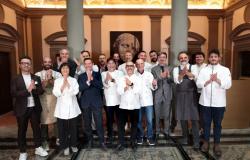“Enjoy it,” the coach said Fabio Pecchia to the fans of Parmawhich on May 1st with a draw in Bari he achieved for the promotion to Serie A for the fourth time, in the third to last match of a Serie B championship dominated from start to finish (Parma have been top of the table for 35 of the 36 matchdays played so far). «Enjoy it» said Pecchia, and anyone who has followed the events of the Emilian team in recent seasons understands the message perfectly.
The end of a complicated period
This promotion closes one of the most complicated sporting periods in Parma’s history. For some years his fans (including this writer) had become pessimistic: there was always the feeling in the air that it would end badly, even when things seemed to be going well. It wasn’t what Parma had accustomed us to: since it arrived in Serie A for the first time, in 1990, it was normal for the Crusader club to exceed expectations.
As newly promoted in ’90, Parma finished the championship in fifth place. The following year he won the Italian Cupthe one after that Cup Winners’ Cuptherefore the European Super Cupafter which the UEFA Cup. A good decade at the highest levels was enough for Parma to become the fourth Italian team with the most international trophies, immediately after Milan, Inter and Juventus. Even following the two failures, first at the time of Parmalatthen at the end of the years of management of the Brescia area Tommaso Ghirardi, Parma has always held up and started again, sometimes with unthinkable results. As the rise from D to A with four promotions in four yearssomething that no one in Italy had ever done before.
It was the 2020-21 Serie A championship, the third after his return from the amateurs, making Parma fans pessimistic. A tournament that began with a sumptuous signing campaign (over one hundred million euros spent on new signings) and ended badly: last, with only 20 points and an incredible series of wasted opportunities. Match after match, a huge gap has opened up between the legitimate aspirations of the fans and the reality on the pitch.
It happened again the following year: relegated to Serie B, Parma recruited two champions in Gigi Buffon and Franco Vazquez. The ascent seemed like a formality. Instead the team didn’t even finish eighth, the last place to access the playoffs to compete for promotion. The following year they reached the playoffs and seemed headed towards Serie A: in the semi-final of the first leg Cagliari won 2-0 after less than half an hour. The comeback of the Sardinian team, with three goals in the last twenty-five minutes, and a ball that hit the bottom of the crossbar to bounce off the Cagliari goal line in the return match (a one-nil was enough to go through… ) confirmed that that bad feeling wasn’t unreasonable. Yes, even when it seemed like it was the right time, in the end it wasn’t.
Parma president, Kyle Krause, carried in triumph – Parma Calcio 1913
Krause’s project
This is why Parma’s return to Serie A is different this time: it has the liberating force of emerging from what seemed like a bad moment but instead never ended. It is the victory that must be “enjoyed” as only those who have found joy after too many disappointments or those who have conquered the summit after a much longer and more tiring climb than expected can do. And now we can look around with reasonable optimism.
The last time Parma spent three years in a row in Serie B was at the end of the 1980s, right before the promotion that opened those twelve incredible years which brought the twelve trophies now housed in the Museo del Tardini and made fans fall in love with champions like Zola, Asprilla, Crespo, Buffon, Thuram or Cannavaro. Today, however, is a different story. These are no longer the years of Calisto’s exaggerated purchases and boundless ambitions (even beyond the confines of legality). Tanzibut those of the American entrepreneur Kyle Krause, who comes from Iowa but has Palermo origins and is in love with Italy.
Krause61 years old, made his fortune with Kum&Go, a chain of gas station-related convenience stores in the United States. Last year he sold it (according to the financial agency Reuters for a figure close to 2 billion dollars) and today Parma Calcio is one of the main activities of the Krause Group, which also controls two large ranches in the United States, the Des Moines Menace and Pro Iowa football teams but above all in Italy he bought two historic Piedmontese wineries (Vietti and Enrico Serafino) and started a five-star resort in the Langhe.
He is another American owner of Italian clubs, but he has a very different approach to that of investment funds seeking quick profits in the football business. Krause Group defines itself as a family business whose mission is “to improve the way people experience the world by cultivating a family of brands while creating opportunities to do good.” In the few interviews granted, the Parma president said he considers himself a “social entrepreneur” who leads companies “linked to the territory, eco-sustainable, respectful and loved by the community” and makes long-term investments also thinking of his children and grandchildren (in Parma his son Oliver is especially involved).
He has no shortage of resources: he has invested between purchasing the club and covering his losses 357 million euros in the Emilian club in these four years. The project for the new Tardini Stadium, a reconstruction from scratch to build a modern facility in the city center that will contribute to the team’s revenues, seems close to final approval. He also launched the women’s team, which also aims to rise to Serie A.
Investing in young people (and making them play)
At a sporting level, the project is clear: investing in young people and the youth sector. The Parma scouts, led by sporting director Mauro Pederzoli, have the task of finding quality young players “who can guarantee the club a sporting and economically sustainable future”, as Krause himself explained to Gazzetta dello Sport.
A strategy that has its risks (especially in the psychological balance of a team made up of young people full of talent but not experience) but which this year has shown that it can be successful. Parma achieved promotion with the third youngest squad in the category (average age 24.8 years), made up entirely of owned players who are starting to have several dozen matches played among professionals.
Some are catching the interest of big European clubs. Above all the Catalan midfielder Adrian Bernabé22 year old who trained in the youth teams of Barcelona and Manchester City, or the striker Ange-Yoan Bonny (20 year old discovered three years ago in the French fifth series), but also the 23 year old Polish winger Adrian Benedyczakalready in the national team, the Swiss midfielder Simon Sohm (23 years old) or the central defender Alessandro Circati, who at the age of 20 has already made his debut with Australia (he is the son of a footballer from Fidentino who emigrated to Perth). Added to these are more mature players, such as the Romanians Dennis Man and Valentin Mihăilă (25 and 24 years old respectively) already permanently in their national team, and some “experts”, such as Christian Ansaldithe former Inter and Torino winger who at 37 years old together with the captain Enrico Del Prato (24-year-old full-back from the Atalanta school) is one of the leaders of the locker room.
Fabio Pecchia, coach of Parma – Parma Calcio 1913
“All in” players
The team arrives in Serie A with a team whose balance and patterns have now been consolidated in the two years of Pecchia’s management, who won his third promotion after those with Verona and Cremonese. Two years ago Pecchia chose to leave Cremona, where he had just achieved his goal of Serie A, to join Krause’s Parma project. Student of Rafa Benítez, always faithful to his 4-2-3-1 and attacking play, has imposed in words and deeds the idea that the players are “all in”. Rarely has the Parma coach fielded the same formation twice in a row.
In every press conference he reiterated that there are no starters and substitutes, but Parma is playing, and those who come in during the match have no less chance of contributing to the team’s success than those who started from the beginning. If the team imposed itself on the others from start to finish in the championship it was not only due to the quality and breadth of the squad, objectively the best in Serie B, but also due to the ability to form a group which clearly emerged in this season, with a psychological solidity that has allowed Parma to win many matches with goals scored in the last minutes of the game. A young squad, a strong group, solid ownership: everything seems to be there to make a good impression even in the top flight.
«Parma is back. Nature is healing” the American journalist wrote on Twitter James Horncastlewhich follows Serie A for The Athleticthe sports newspaper of New York Times. «ParmAgain» is the motto chosen by the club to celebrate this victory. For Parma fans, the latest absence from the top flight was painful and certainly too long. For what the yellow and blue have done in great football from 1990 onwards, there is no need to be biased to think that Serie A has also missed Parma a lot.






